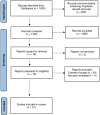A scoping review of mobile apps for sleep management: User needs and design considerations
- PMID: 36329917
- PMCID: PMC9624283
- DOI: 10.3389/fpsyt.2022.1037927
A scoping review of mobile apps for sleep management: User needs and design considerations
Abstract
Sleep disorders are prevalent nowadays, leading to anxiety, depression, high blood pressure, and other health problems. Due to the proliferation of mobile devices and the development of communication technologies, mobile apps have become a popular way to deliver sleep disorder therapy or manage sleep. This scoping review aims to conduct a systematic investigation of mobile apps and technologies supporting sleep, including the essential functions of sleep apps, how they are used to improve sleep and the facilitators of and barriers to using apps among patients and other stakeholders. We searched articles (2010 to 2022) from Scopus, Web of Science, Science Direct, PubMed, and IEEE Xplore using the keyword sleep apps. In total, 1,650 peer-reviewed articles were screened, and 51 were selected for inclusion. The most frequently provided functions by the apps are sleep monitoring, measuring sleep, providing alarms, and recording sleep using a sleep diary. Several wearable devices have been used with mobile apps to record sleep duration and sleep problems. Facilitators and barriers to using apps were identified, along with the evidence-based design guidelines. Existing studies have proved the initial validation and efficiency of delivering sleep treatment by mobile apps; however, more research is needed to improve the performance of sleep apps and devise a way to utilize them as a therapy tool.
Keywords: human computer interaction; mobile apps; sleep apnea; sleep disorder; sleep management.
Copyright © 2022 Al Mahmud, Wu and Mubin.
Conflict of interest statement
The authors declare that the research was conducted in the absence of any commercial or financial relationships that could be construed as a potential conflict of interest.
Figures
References
-
- Adams R, Appleton S, Taylor A, McEvoy D, Antic N. Report to the Sleep Health Foundation 2016 Sleep Health Survey of Australian Adults. Adelaide: The Adelaide Institute for Sleep Health and The University of Adelaide; (2016).
Publication types
LinkOut - more resources
Full Text Sources


